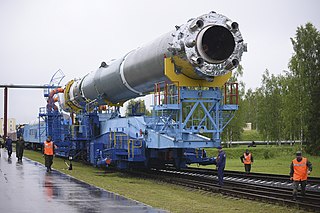Related Research Articles

Soyuz is a family of expendable Russian and Soviet carrier rockets developed by OKB-1 and manufactured by Progress Rocket Space Centre in Samara, Russia. With over 1,900 flights since its debut in 1966, the Soyuz is the rocket with the most launches in the history of spaceflight.

PAO S. P. Korolev Rocket and Space Corporation Energia, also known as RSC Energia, is a Russian manufacturer of spacecraft and space station components. The company is the prime developer and contractor of the Russian crewed spaceflight program; it also owns a majority of Sea Launch. Its name is derived from Sergei Korolev, the first chief of its design bureau, and the Russian word for energy.

The Angara rocket family is a family of launch vehicles being developed by the Moscow-based Khrunichev State Research and Production Space Center. The launch vehicles are to put between 3,800 kg (8,400 lb) and 24,500 kg (54,000 lb) into low Earth orbit and are intended, along with Soyuz-2 variants, to replace several existing launch vehicles.

The staged combustion cycle is a power cycle of a bipropellant rocket engine. In the staged combustion cycle, propellant flows through multiple combustion chambers, and is thus combusted in stages. The main advantage relative to other rocket engine power cycles is high fuel efficiency, measured through specific impulse, while its main disadvantage is engineering complexity.

The Soyuz-U launch vehicle was an improved version of the original Soyuz rocket. Soyuz-U was part of the R-7 family of rockets based on the R-7 Semyorka missile. Members of this rocket family were designed by the TsSKB design bureau and constructed at the Progress factory in Samara, Russia. The first Soyuz-U flight took place on 18 May 1973, carrying as its payload Kosmos 559, a Zenit military surveillance satellite. The final flight of a Soyuz-U rocket took place on 22 February 2017, carrying Progress MS-05 to the International Space Station.

The RD-170 is the world's most powerful and heaviest liquid-fuel rocket engine. It was designed and produced in the Soviet Union by NPO Energomash for use with the Energia launch vehicle. The engine burns kerosene fuel and LOX oxidizer in four combustion chambers, all supplied by one single-shaft, single-turbine turbopump rated at 170 MW (230,000 hp) in a staged combustion cycle.

The NK-33 and NK-43 are rocket engines designed and built in the late 1960s and early 1970s by the Kuznetsov Design Bureau. The NK designation is derived from the initials of chief designer Nikolay Kuznetsov. The NK-33 was among the most powerful LOX/RP-1 rocket engines when it was built, with a high specific impulse and low structural mass. They were intended for the ill-fated Soviet N1F Moon rocket, which was an upgraded version of the N1. The NK-33A rocket engine is now used on the first stage of the Soyuz-2-1v launch vehicle. When the supply of the NK-33 engines are exhausted, Russia will supply the new RD-193 rocket engine. It used to be the first stage engines of the Antares 100 rocket series, although those engines are rebranded the AJ-26 and the newer Antares 200 and Antares 200+ rocket series uses the RD-181 for the first stage engines, which is a modified RD-191, but shares some properties like a single combustion chamber unlike the two combustion chambers used in the RD-180 of the Atlas V and the four combustion chambers used in the RD-170 of the Energia and Zenit rocket families, and the RD-107, RD-108, RD-117, and RD-118 rocket engines used on all of the variants of the Soyuz rocket.

The Main Missile and Artillery Directorate of the Ministry of Defense of the Russian Federation, commonly referred to by its transliterated Russian acronym GRAU (ГРАУ), is a department of the Russian Ministry of Defense. It is subordinate to the Chief of Armament and Munition of the Russian Armed Forces, a vice-minister of defense.
Fregat (Russian: Фрегат, frigate) is an upper stage developed by NPO Lavochkin in the 1990s, which is used in some Soyuz and Zenit launch vehicles, but is universal and can be used as a part of a medium and heavy class launch vehicles. Fregat became operational in February 2000. Its liquid propellant engine uses UDMH and N2O4. Fregat's success rate is 97.8% (with 2 failures in 93 launches), which makes it one of the most reliable upper stages in the world. Fregat has successfully delivered more than 300 payloads into different orbits. It remains the only upper stage in the world that can place its payload into 3 or more different orbits in a single launch.

Soyuz-2 is a modernised version of the Soviet Soyuz rocket. In its basic form, it is a three-stage launch vehicle for placing payloads into low Earth orbit. Compared to the previous versions of the Soyuz, the first-stage boosters and two core stages feature uprated engines with improved injection systems. Digital flight control and telemetry systems allow the rocket to be launched from a fixed launch platform, whereas the launch platforms for earlier Soyuz rockets had to be rotated as the rocket could not perform a roll to change its heading in flight.

The Soyuz-FG launch vehicle was an improved version of the Soyuz-U from the R-7 family of rockets, designed and constructed by TsSKB-Progress in Samara, Russia. Guidance, navigation, and control system was developed and manufactured by "Polisvit" Special Design Bureau.

This comparison of orbital launch systems lists the attributes of all individual rocket configurations designed to reach orbit. A first list contains rockets that are operational or in development as of 2023; a second list includes all upcoming rockets and a third list includes all retired rockets For the simple list of all conventional launcher families, see: Comparison of orbital launchers families. For the list of predominantly solid-fueled orbital launch systems, see: Comparison of solid-fueled orbital launch systems.

The RD-0124 is a rocket engine burning liquid oxygen and kerosene in an oxygen-rich staged combustion cycle, developed by the Chemical Automatics Design Bureau in Voronezh. RD-0124 engines are used on the Soyuz-2.1b and Soyuz-2-1v. A variant of the engine, the RD-0124A, is used on the Angara rocket family's URM-2 upper stage.

The Soyuz-2.1v, GRAU index 14A15, known earlier in development as the Soyuz-1, is a Russian expendable launch vehicle. It is a heavily modified derivative of the Soyuz-2.1b, and is a member of the R-7 family of rockets. It is built by TsSKB Progress, at Samara in Russia. Launches are conducted from existing facilities at the Plesetsk Cosmodrome in Northwest Russia, with pads also available at the Baikonur Cosmodrome in Kazakhstan, and new facilities at the Vostochny Cosmodrome in Eastern Russia.

In 2015, the maiden spaceflights of the Chinese Long March 6 and Long March 11 launch vehicles took place.
Aist 1 is a Russian technology demonstration satellite which was launched in December 2013. Aist 1 is operated by the Samara Aerospace University, who constructed it in partnership with TsSKB Progress. It is the second launched Aist satellite, following Aist 2's April 2013 launch.
The flight of Angara-1.2pp was the maiden flight of Russia's Angara series of rockets. This flight was conducted successfully on 9 July 2014. A unique configuration with parts taken from the Angara-1 and Angara-A5 rockets, the suborbital mission served to flight test each of the new stages developed for the rocket ahead of its operational use.

The RD-0110R is a rocket engine burning kerosene in liquid oxygen in a gas generator combustion cycle. It has four nozzles that can gimbal up to 45 degrees in a single axis and is used as the vernier thruster on the Soyuz-2-1v first stage. It also has heat exchangers that heat oxygen and helium to pressurize the LOX and RG-1 tanks of the Soyuz-2.1v first stage, respectively. The oxygen is supplied from the same LOX tank in liquid form, while the helium is supplied from separate high pressure bottles.
Voronezh Mechanical Plant is a Russian engine and heavy machinery manufacturing plant. It is located in the city of Voronezh, in the Voronezh Oblast.

Soyuz 7K-L1E was a Soviet uncrewed modified Soyuz 7K-L1 spacecraft. Also called a dummy Soyuz 7K-LOK. Two were built, one Soyuz 7K-L1E was successfully launched into Low Earth Orbit on Proton rocket and is known as Kosmos 382. The other Soyuz 7K-L1E was placed on a N1 rocket, which failed at launch. The Soyuz spacecraft was first used in 1967 as the main crewed spacecraft and is still in use. Many Soyuz variations have been built and the Soyuz 7K-L1E was an uncrewed variation.
References
- ↑ "Volga upper stage". Russianspaceweb.com. Retrieved 10 March 2016.
- ↑ "Soyuz-2-1v Launcher (formerly Soyuz-1)" . Retrieved 26 March 2016.
- 1 2 "Soyuz 2-1 launches maiden mission from Vostochny | NASASpaceFlight.com". www.nasaspaceflight.com. Retrieved 2016-05-01.
- ↑ "Soyuz 2-1v Launch Vehicle". Spaceflight101. Retrieved 26 March 2016.